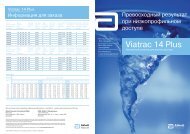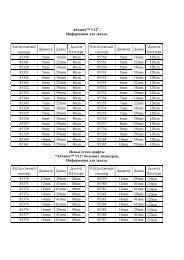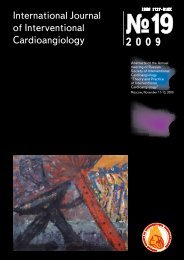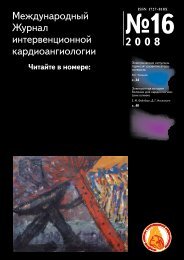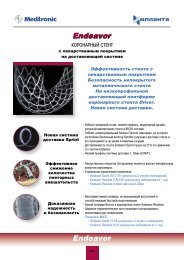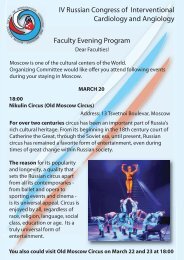International Journal of Interventional Cardioangiology
International Journal of Interventional Cardioangiology
International Journal of Interventional Cardioangiology
Create successful ePaper yourself
Turn your PDF publications into a flip-book with our unique Google optimized e-Paper software.
MUSCELLANONEOUS<br />
Cardiac complaints (palpitation, heart irregularity,<br />
cardiodynia) were more frequently observed in children<br />
with ARVI (27% (6) children), and children with<br />
HI – 2.5 times less frequently (11% (5) patients). On<br />
physical examination, heart area was not changed in<br />
any child. The borders <strong>of</strong> relative heart dullness were<br />
insignificantly displaced to the left (0.5-1.0 cm) in<br />
2 (5%) children with HI and in 6 (27%) children with<br />
ARVI.<br />
Physical cardiovascular changes observed in<br />
acute period were common in children with ARVI and<br />
were characterized with moderately muffled apical<br />
first sound (10-45% and 13-30%, respectively). In<br />
a half <strong>of</strong> observations, in 21 (48%) patients with HI<br />
and in 12 (55%) children with ARVI, systolic murmur<br />
was heard at point V (third intercostal space) and/<br />
or left parasternal region, which was possibly due<br />
to increasing hemodynamical significance <strong>of</strong> minor<br />
cardiac malformations on the background <strong>of</strong> acute<br />
infectious toxicosis and changes in hemorheology<br />
parameters (3).<br />
Various changes were revealed on the initial ECG<br />
recordings within first three days after admission in<br />
all children. Sinus node dysfunction (atrial rhythm,<br />
pacemaker migration and/or significant bradycardia<br />
with the episodes <strong>of</strong> sinoatrial block) was recorded<br />
in 46% patients with ARVI and in 31% patients with<br />
HI. In children with ARVI there was a greater trend<br />
towards more fast recovery <strong>of</strong> sinus node function<br />
with 2.2-fold decrease in the incidence <strong>of</strong> significant<br />
bradycardia, 3-fold decrease in the incidence <strong>of</strong><br />
atrial rhythm, and 1.3-fold decrease in the incidence<br />
<strong>of</strong> pacemaker migration on Days 10-14 simultaneously<br />
with disappearance <strong>of</strong> intoxication symptoms.<br />
In children with HI there was a similar decrease in the<br />
incidence <strong>of</strong> atrial rhythm (3 fold), but pacemaker<br />
migration rate was higher in 1.5 times, and there was<br />
no change over time in bradycardia incidence (23%).<br />
Change in atrio-ventricular conduction (PQ prolongation<br />
or shortening) was found during acute period<br />
with similar incidence both in children with ARVI and<br />
in children with HI (32%). There was more evident<br />
normalization <strong>of</strong> AV conduction over time in children<br />
with ARVI (9%) with 3.5-fold decrease in the incidence<br />
<strong>of</strong> conduction disturbances as compared to<br />
patients with HI (20%). Intraventricle conduction disturbances<br />
were observed in 39% <strong>of</strong> children with HI<br />
during acute period and in 43% patients over time. In<br />
patients with AVRI these changes were characterized<br />
with evident positive changes over time with almost<br />
2-fold decrease in their incidence during recovery<br />
period (50% and 28%, respectively). Repolarization<br />
abnormalities on the initial ECG recording occurred<br />
totally in one third <strong>of</strong> patients with viral infections<br />
regardless <strong>of</strong> the etiology. In children with ARVI, evident<br />
marked positive changes over time in the end<br />
part <strong>of</strong> QRS with 3-fold decrease in the incidence<br />
<strong>of</strong> ST-T changes were observed during recovery<br />
period. In children with HI, the repolarization abnormalities<br />
were characterized with more significant<br />
stability, these were observed in 34% children on the<br />
initial recordings and persisted over time till Day 14<br />
in 30% patients.<br />
Thus, during acute period <strong>of</strong> viral infections the<br />
ECG changes including combined changes were<br />
found more <strong>of</strong>ten in children with ARVI and were<br />
characterized with evident positive changes during<br />
recovery period with more than 3.5 fold decrease<br />
in their incidence. This may suggest a favorable<br />
prognosis for cardiovascular changes occurring in<br />
children with infectious toxicosis. In children with HI,<br />
the ECG changes were more persistent and there<br />
were no positive changes over time in a number <strong>of</strong><br />
parameters.<br />
Analysis <strong>of</strong> vegetative homeostasis revealed the<br />
signs <strong>of</strong> vegetative dysfunction, generally <strong>of</strong> one-way<br />
pattern in 82% <strong>of</strong> children with ARVI, and in 89% children<br />
with HI (Table 1). In a half <strong>of</strong> children, baseline<br />
vegetative tone was characterized with sympathicotonia,<br />
with hypersympathicotonia dominating in<br />
children with ARVI. Change in the vegetative provision<br />
<strong>of</strong> activity with absolute domination <strong>of</strong> insufficient<br />
provision was observed in one third <strong>of</strong> children.<br />
Disturbance <strong>of</strong> the vegetative reactivity was more<br />
typically for children with HI (83%), they had similar<br />
incidence <strong>of</strong> asympathicotonic reactivity and hypersympathicotonia;<br />
the latter is unusual for recovery<br />
period.<br />
Table 1. Characteristics <strong>of</strong> vegetative homeostasis in children with viral<br />
infections during recovery period.<br />
Children<br />
groups<br />
BVS VAP VR<br />
E V S HS Norm Insuf Exc Norm Asymp HSR<br />
HI (n=18) 28% 16% 28% 28% 67% 33% - 17% 50% 33%<br />
ARVI (n=22) 36% 18% 14% 32% 64% 32% 4% 32% 45% 23%<br />
Note: BVS – baseline vegetative tone (E – eutonia, V – vagotonia, S –<br />
sympathicotonia, HS - hypersympathicotonia), VP – vegetative activity<br />
provision (Norm – normal provision, Insuf – insufficient; Exc - excessive),<br />
VR – vegetative reactivity (Norm – normal reactivity; Asymp –<br />
asympathicotonia; HSR – hypersympathicotonic reactivity)<br />
Disturbances <strong>of</strong> adaptive resources <strong>of</strong> the vegetative<br />
nervous system observed in the majority<br />
<strong>of</strong> examined children (68% - ARVI, 77% - HI) were<br />
characterized with the prevalence <strong>of</strong> central nervous<br />
regulation <strong>of</strong> vegetative homeostasis with adaptation<br />
exertion in 80% <strong>of</strong> children.<br />
The evaluation <strong>of</strong> mean morphometric echocardiographic<br />
parameters in children with viral infections<br />
showed no significant deviations from the reference<br />
data taking into account age, sex, and body surface<br />
area. Minimal dysfunction <strong>of</strong> the left ventricle,<br />
i.e. moderate increase in cardiosystolic and cardiodiastolic<br />
dimensions and volumes and/or decreased<br />
ejection fraction, was revealed in 26% (6) <strong>of</strong> children<br />
with HI and in 14% (3) <strong>of</strong> children with ARVI. Minimal<br />
pericardial effusion with separation <strong>of</strong> the pericardial<br />
sheets at the level <strong>of</strong> papillary muscles (up to 3-4<br />
mm) was observed in 18% (4) <strong>of</strong> patients with ARVI<br />
and in 9% (2) <strong>of</strong> patients with HI. These changes<br />
Heterophil Anti-Cardiac Antibodies and Cardiovascular Changes<br />
in Children with Viral Infections<br />
47




